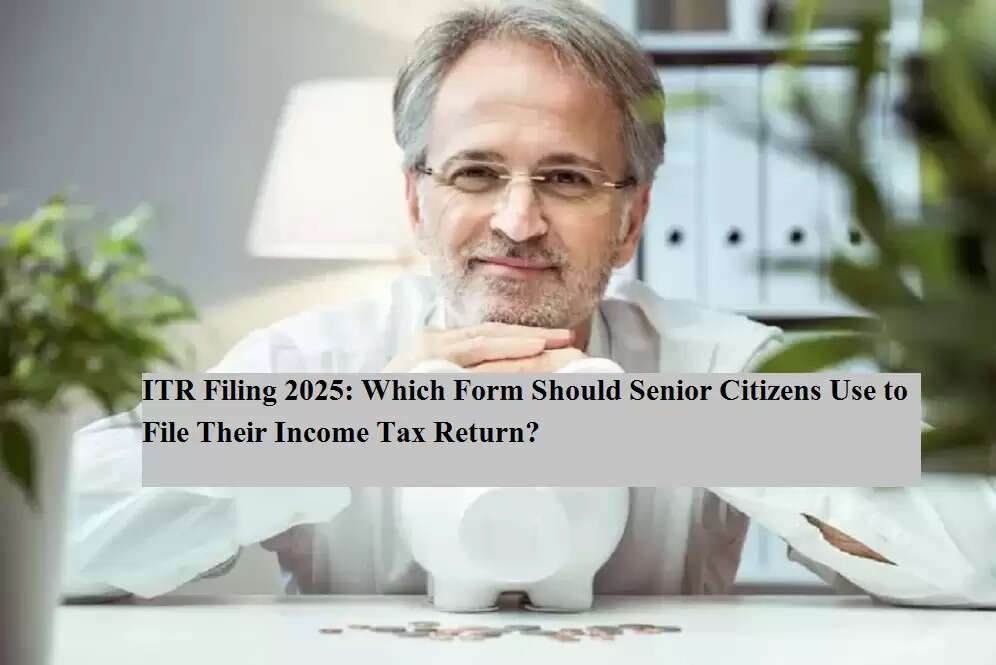ITR Filing 2025: Which Form Should Senior Citizens Use to File Their Income Tax Return?

As the deadline for filing Income Tax Returns (ITR) for Financial Year 2024-25 approaches, it's essential for senior citizens and super senior citizens to determine which ITR form is applicable to them. The Income Tax Department offers different ITR forms depending on the taxpayer’s age, income type, and source of income.
👴 Who Qualifies as a Senior or Super Senior Citizen?
-
Senior Citizen: Age 60 years or above
-
Super Senior Citizen: Age 80 years or above
🛑 Exemption from Filing ITR Under Section 194P
Under Section 194P of the Income Tax Act, 1961, senior citizens aged 75 years or above may be exempted from filing ITR—but only if the following conditions are fulfilled:
-
Age is 75 years or more during the financial year.
-
Income is only from pension and interest (interest must be from the same bank where the pension is credited).
-
A declaration has been submitted to the bank.
-
The bank deducts TDS on behalf of the senior citizen under Section 194P.
✅ If all conditions are met, there's no need to file ITR.
❌ If any of the above conditions are not met, the senior citizen must file ITR manually or online, based on their income profile.
📄 ITR Forms Available for Senior Citizens in FY 2024-25
There are four ITR forms commonly used by senior citizens depending on the type and amount of income:
✅ 1. ITR-1 (Sahaj) – For Individuals
Applicable if:
-
Total income ≤ ₹50 lakh
-
Income includes:
-
Pension or Salary
-
One house property
-
Other sources (interest, family pension, dividends)
-
Agricultural income ≤ ₹5000
-
Not applicable if:
-
Director in a company
-
Holds unlisted equity shares
-
Has foreign assets or signing authority in overseas accounts
-
Earns income from outside India
-
Subject to TDS under section 194N or deferred ESOP tax
-
Has business or professional income
✅ 2. ITR-2 – For Individuals and HUFs
Applicable if:
-
Income does NOT include income from business or profession
-
Individuals/HUFs who are not eligible to file ITR-1
✅ 3. ITR-3 – For Business/Professional Income
Applicable if:
-
Individual or HUF earns income from business or profession
-
Not eligible to file ITR-1, ITR-2, or ITR-4
✅ 4. ITR-4 (Sugam) – For Presumptive Income
Applicable if:
-
Total income ≤ ₹50 lakh
-
Resident individual or HUF
-
Income from:
-
Pension/Salary
-
One house property
-
Other sources (interest, dividends, etc.)
-
Presumptive business or profession under sections 44AD/44ADA/44AE
-
Agricultural income ≤ ₹5000
-
Not applicable if:
-
Director in a company
-
Holds unlisted equity shares
-
Has foreign income or assets
-
Deferred tax on ESOPs
-
Income exceeds ₹50 lakh
⚠️ Note: ITR-4 is optional, not mandatory, even if conditions are met.
✅ Which ITR Form Should Most Senior Citizens Use?
| Income Type | Suitable Form |
|---|---|
| Only Pension & Interest (≤ ₹50 lakh) | ITR-1 (Sahaj) |
| Pension + Capital Gains or More Complex Sources | ITR-2 |
| Business/Profession Income | ITR-3 or ITR-4 (if under presumptive scheme) |
| Presumptive Business Income + Pension | ITR-4 (Sugam) |
📌 Final Tips for Senior Citizens
-
Check whether you qualify for exemption under Section 194P.
-
Keep all documents like Form 16, pension slips, interest certificates, and Form 26AS ready.
-
Consider e-filing for faster processing and refunds.
-
Seek help from a CA or Tax Return Preparer (TRP) if unsure about the correct ITR form.




















